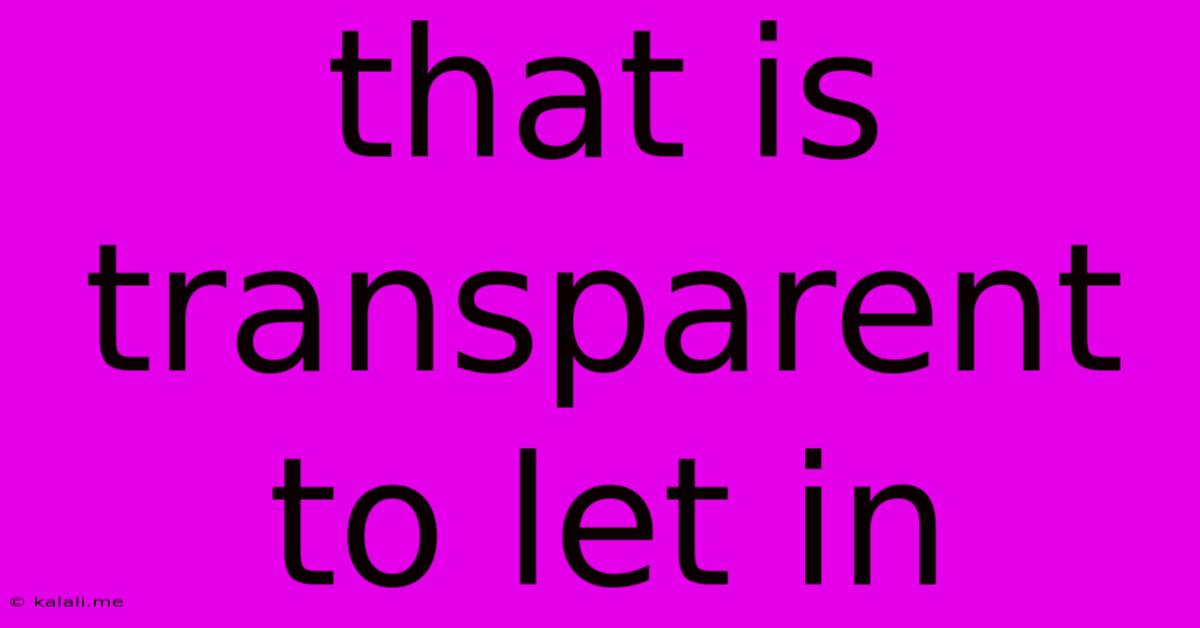That Is Transparent To Let In
Kalali
Jun 05, 2025 · 3 min read

Table of Contents
Materials That Are Transparent to Let in Light: A Comprehensive Guide
Meta Description: Discover a range of materials boasting transparency, allowing light transmission for diverse applications, from everyday windows to advanced technologies. Learn about their properties, uses, and limitations.
Transparency, the ability to allow light to pass through without significant scattering or absorption, is a crucial property in many fields. From the humble window pane to sophisticated optical instruments, materials that are transparent play a vital role in our daily lives and technological advancements. This article delves into the world of transparent materials, exploring their characteristics, applications, and the science behind their transparency.
Understanding Transparency
Transparency isn't simply about seeing through something; it's a complex interplay of how light interacts with the material's atomic structure. When light strikes a transparent material, its photons pass through with minimal interaction, allowing us to see objects on the other side. This contrasts with opaque materials, where light is either absorbed or scattered, preventing clear vision. The degree of transparency can vary, ranging from perfectly clear glass to slightly hazy plastics.
Several factors influence a material's transparency:
- Refractive Index: This measures how much light bends when passing through the material. A lower refractive index generally means greater transparency.
- Absorption: Materials absorb light at specific wavelengths. If a material absorbs a significant portion of the visible light spectrum, it will appear less transparent.
- Scattering: Imperfections within a material's structure can scatter light, reducing transparency. This is why even perfectly clear glass can have variations in clarity depending on its quality.
- Wavelength of Light: Transparency is wavelength-dependent. A material might be transparent to visible light but opaque to ultraviolet or infrared light.
Common Transparent Materials and Their Applications
Numerous materials exhibit transparency, each with its unique properties and applications:
-
Glass: Perhaps the most common transparent material, glass is widely used in windows, lenses, and various other applications. Different types of glass, like borosilicate glass or fused silica, offer varying levels of transparency and resistance to heat or chemicals.
-
Plastics: Many plastics, such as acrylic (polymethyl methacrylate or PMMA) and polycarbonate, are transparent and used in diverse applications, including lenses, protective shields, and display screens. They are often lighter and more impact-resistant than glass.
-
Crystals: Certain crystals, like quartz and sapphire, are highly transparent and find use in optical instruments and high-precision applications due to their exceptional clarity and resistance to scratching.
-
Water: Pure water is remarkably transparent, allowing light to penetrate to significant depths. Its transparency is crucial for aquatic life and plays a key role in various natural processes.
-
Air: While often overlooked, air is also a transparent medium, allowing light to travel vast distances. Its transparency is fundamental to our ability to see the world around us.
Beyond Simple Transparency: Advanced Applications
Transparency is not limited to simply letting light pass through; research is exploring advanced materials and techniques to manipulate light transmission for specific applications:
-
Electrochromic Materials: These materials can switch between transparent and opaque states using an electric current, enabling applications like smart windows that control light and heat transmission.
-
Metamaterials: These artificially engineered materials can exhibit unique optical properties, including perfect transparency or invisibility at specific wavelengths.
Conclusion
Transparency is a fascinating property with far-reaching implications across numerous scientific and technological fields. Understanding the factors influencing transparency and the properties of various transparent materials is crucial for developing new technologies and improving existing applications. From everyday windows to advanced optical devices, transparent materials continue to shape our world.
Latest Posts
Latest Posts
-
Can You Pop Microwave Popcorn On Stove
Jun 07, 2025
-
How To Sort By Kind And Name On Mac
Jun 07, 2025
-
How To Kill Villager Without Losing Reputation
Jun 07, 2025
-
3 Wire To 2 Wire Battery
Jun 07, 2025
-
Is A Map Of Counties Polygon Data
Jun 07, 2025
Related Post
Thank you for visiting our website which covers about That Is Transparent To Let In . We hope the information provided has been useful to you. Feel free to contact us if you have any questions or need further assistance. See you next time and don't miss to bookmark.